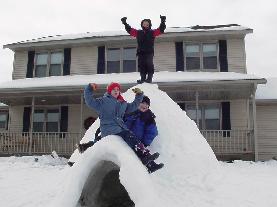
Chippewa Herald * January 14, 2008
A well-built igloo should last the whole winter
We finally have a real winter! After the last few years, I was beginning to lose hope. But the tons of snow in December were a sight for sore eyes. At last, this would be the winter that we could get back to making igloos. I always dreamed about making igloos as a kid. But my brother and I could never seem to complete one. Sure, we could make blocks of snow with a mold, and even start stacking them up in a circle -- but how on earth do you put a ceiling on it? The closest we ever came is a snow cave. This was something that our dad dug out of the pile of snow between our driveway and our neighbor's driveway that reached over even our dad's head. The mid-1960s were good for years for snow. The snow cave was cool, but it was not really an igloo. In 2001, an old friend of mine, Linda Gehrig, mentioned an igloo maker that she had heard about. Thanks to the Internet, I was able to locate the company and order one online before she could even get to a store in the Twin Cities to buy one! (We're very competitive, and I won that round.) The "Ice Box," from Colorado-based "Grand Shelters," was my ticket to igloo paradise. It actually works! The Ice Box uses the concept of a mold for forming bricks, but does oh, so much more. The real secret is the adjustable pole that controls not only the radius of the wall for each layer of bricks, but also the bricks' angle. You start off by driving a plastic stake in the ground. A four-foot metal pole connects the stake to a three-sided plastic box, which defines bricks in the wall. It's very important to keep the center stake in place, so that the upper layers line up with the lower layers. In our family, the youngest kid has the sole duty of sitting on the center stake to keep it in place. The other kids simply dump shovels of snow into the box. When it's full, I pack it down to solidify it. (The manufacturer claims that you can even do this with powdery snow, given enough time and pressure -- but "sticky" snow sure is easier!) When that brick is complete, I lift the bracket holding the right end of the box together. That loosens the box just enough to allow me to carefully slide the box to the left by one brick, where we repeat the process. The pole eventually guides the bricks into a complete circle. When it comes time for layer two, we adjust the pole from the "1" marking to "2". This forces the second layer in a bit, making a smaller circle, and also changes the angle to make those bricks lean in more. Layers three and four are more of the same. By the time we get to the fifth layer, it's angled in even more and too high to hand pack, so we remove the outer side of the box and the kids just throw shovels of snow up at it. Layers five through eight go quite quickly, since the radius is very small by now. Strangely enough, though, the pole actually gets LONGER for those layers. The reason for this is that the ceiling has to be quite high for proper support. The shape is definitely NOT a hemisphere. The designers of the Ice Box knew that a structurally sound igloo needs to follow the shape of a catenary curve, the same mathematical equation (hyperbolic cosine) as the St. Louis Arch and European cathedrals.
If you've never been inside an igloo, it's an experience like no other. Even with sub-zero temperatures and howling winds in the outside world, the interior is eerily quiet and relatively warm. It's especially fun at night, where one candle warms and illuminates the entire room, with light bouncing off the walls of snow. The next couple years after 2001 were dry, so we couldn't make an igloo until mid-February. The problem with that is that it melts so soon. The last two years we didn't even bother -- it's not worth the effort of building one if you can only use it for a week or two. But this year, with plenty of early snow, I kept reminding the kids that we'd have the igloo around for months, just like the good old days. After finishing an eight-footer on the first Saturday of 2008, we could hardly contain our excitement! Then we read the weather forecast for Sunday -- slightly above freezing. We thought that might be okay, since a little melting would later turn to ice and solidify the new structure. Just to be safe, though, we stopped and bought a tarp on the way home from church Sunday, to protect the igloo from possible rain. When we pulled into the driveway, I wanted to cry -- our precious new igloo had already collapsed, due to the irritatingly unseasonably warm weather. We enjoyed this year's creation for only TWENTY-FIVE HOURS. When are we going to get a REAL winter again?! :-( --------- See photos of our first igloo in 2001: arneberg.com/home/igloo
You can reach Tom at tom@arneberg.com. |
Links: [Tom's column archives] | [Arneberg.com] | [chippewa.com] |
 by Tom Arneberg,
by Tom Arneberg,



